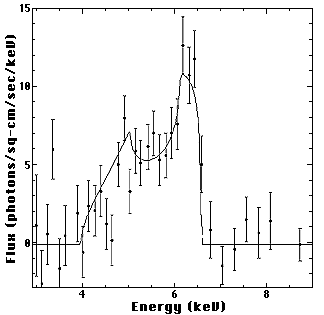|
|
Relativistic accretion disks in AGN
AGN are
believed to contain a massive black hole surrounded by an
accretion
disk. Despite the recent successes in imaging the inner regions
of AGNs (notably using the Hubble Space Telescope), it is still not
possible to take a close-up picture of their inner regions. Scientists
believe that the X-ray emission line data obtained with ASCA have
proven the presence of a relativistic accretion disk.
Emission line photons have a specific energy (or wavelength, or frequency),
dictated by the atomic physics, as seen from the matter that emitted them.
When the emitting matter is moving, then we detect the photons at
Doppler shifted energies. In an accretion disk, material near the outside
moves slower than material in the inner parts. Depending on the angle at
which we observe the accretion disk, and ignoring relativistic effects for
now, emission lines from an accretion disk have a characteristic
double-horned structure.

|
A schematic diagram of the origin of double-horned structure,
for an accretion disk in a binary. Top: Gas in each zone of the disk
is coming toward, or receding from, us with a similar velocity (they
have very different sideways motion but that does not matter for
Doppler shifts). Bottom: Adding up contribution of all the gas in
each zone, we can calculate the emission line profile --- the
result is a characteristic double-horned shape.
|
When the accretion disk surrounds a black hole, however, the relativistic
effect must also be considered. Photons coming from close to the
black hole (those that are also at extreme wings in the non-relativistic
case above) are gravitationally
redshifted,
introducing a characteristic distortion. This is exactly the model that fits
the iron emission line data on several AGNs observed with ASCA, first
demonstrated in a four-day observation of the Seyfert galaxy MCG-6-30-15, as
shown below.

This result is a convincing demonstration of a relativistic accretion
disk surrounding a massive black hole. Indirectly, but surely, we are
observing the regions very close to the central black hole with ASCA
data. Moreover, with further high-quality data,
we can hope to constrain our viewing geometry and whether (or how fast)
the central black hole is rotating.
|
